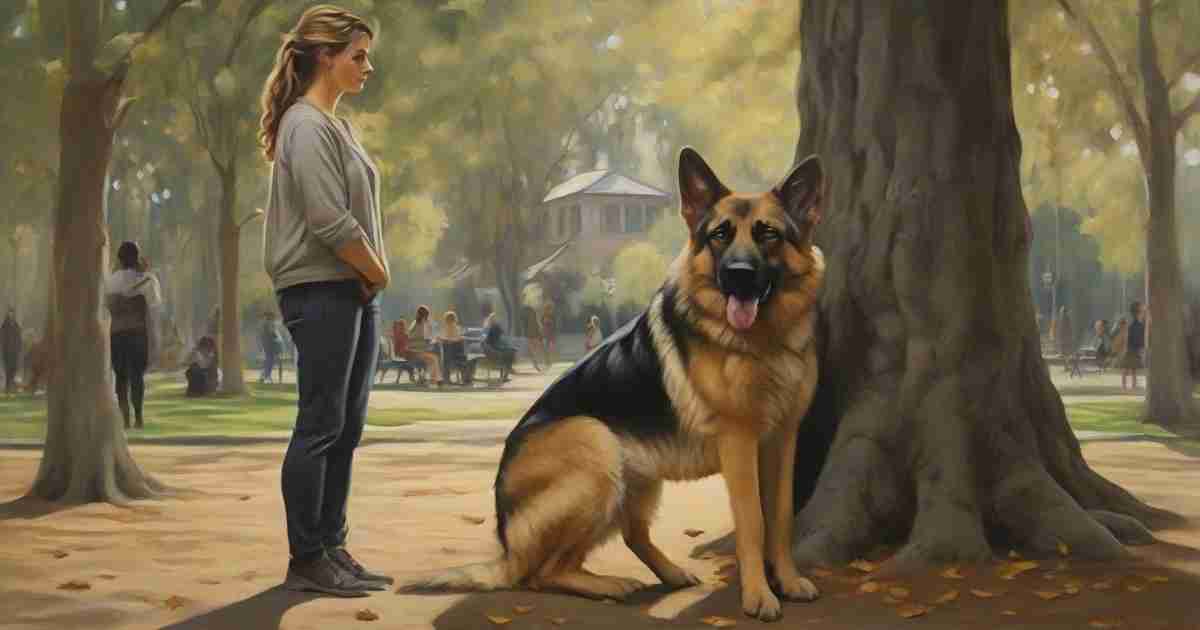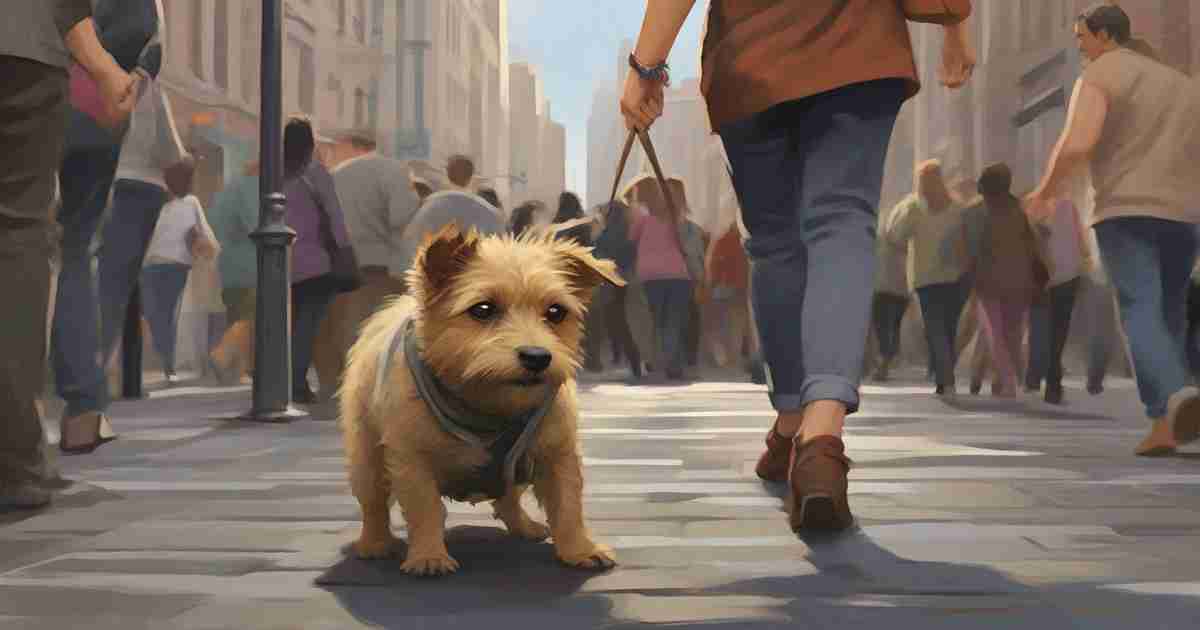Why does your dog stand between your legs? This behavior seems odd to humans and is quite common among dogs. This blog post will explore the possible reasons behind this quirky dog habit and provide some tips for dog owners.
There are a few potential explanations for why your dog insists on sandwiching themselves between your legs:
- Seeking comfort and security
- Showing affection
- Attempting to assert dominance
- Responding to fear or anxiety
While the reasoning isn’t always clear, this behavior likely provides some emotional fulfillment for your dog. It’s important that, as an owner, you respond appropriately.
We will cover topics such as:
- Common dog behaviors and their meaning
- Understanding dog psychology
- Ways to make your dog feel safe and secure
- Training tips for handling behavioral issues
Let’s start by understanding why this mysterious habit develops in the first place.
Understanding Dog Behavior: Why Does My Dog Stand Between My Legs?
A dog’s behavior can sometimes be a mystery to us humans. We might wonder, “Why does my dog stand between my legs?” or engage in unusual behaviors. However, when we take the time to understand dog psychology and communication styles, their actions begin to make more sense.
The Importance of Decoding Dog Behavior
Interpreting our canine companions’ behavior and body language allows us to meet their needs better. Dogs have different instincts, motivations and responses than people. By learning about common dog behaviors and their meanings, owners can:
- Identify when a dog feels anxious or afraid
- Create an environment where they feel safe and secure
- Prevent or resolve undesirable behaviors
- Strengthen the bond through clear communication
Understanding behavior is especially important for powerful breeds like Rottweilers. Their strength requires owners to be calm, consistent pack leaders.
A Dog’s Body Language
While dogs can’t speak our language, they communicate volumes through:
- Facial expressions – Ears, eyes and mouth tell us how they feel
- Body posture – Low, stiff or raised conveys emotions
- Tail height and motion – Also signal their mood
For example, ears flat back against the head demonstrate fear. A wagging tail accompanied by a tense posture often indicates anxiety or social stress. Learning these visual cues allows owners to intervene before situations escalate.
Why Do Dogs Stand Between Our Legs?
So when your dog slides up between your legs looking for attention, what do they mean by it? Here are some possible reasons dogs exhibit this quirky “between the legs” behavior:
- Seeking a feeling of safety and security near their owner
- Attempting to assert dominance over their human pack leader
- Responding to a new or frightening stimulus by hiding
- Showing affection and trying to feel close
Rottweilers may lean between your legs to fulfill an instinct to control their surroundings and feel protected. Or it may simply be them asking for your love and attention!
Providing for Your Dog’s Needs
While dogs have unique ways of demonstrating their needs, we can provide nurturing environments. Methods for accomplishing this include:
- Maintaining strong, predictable leadership so they feel comfortable following you
- Meeting exercise requirements to prevent anxiety or pent-up energy
- Discouraging behaviors like nipping through consistent training
- Ensuring proper socialization and acclimating them to new stimuli
- Creating safe spaces where they can retreat when frightened
The more we understand what our canine friends are trying to communicate, the better equipped we’ll be to fill their safety, confidence and affection needs. By listening with compassion when our dog slides between our legs, we can nurture the loving bond even further.
Reasons for Dogs Standing Between Legs
As dog owners, we’ve all had our canine companions abruptly slide between our legs while standing. You look surprised and wonder…” why does my dog stand between my legs?” This somewhat peculiar behavior has several explanations rooted in dog psychology and communication styles.
Displays of Submissive Behavior
One of the most common reasons dogs stand between human legs is to convey respect and demonstrate submissive behaviors. By placing themselves in this vulnerable position close to your body, they communicate trust and recognize your leadership.
What does submissive behavior mean? Dogs display deferential postures to indicate to their human or another dog that they do not wish to challenge dominance. Submission helps minimize confrontation and reinforces harmony within the family pack structure.
When greeted by new guests, Rottweilers and other large breeds may lean between their legs. Sitting below them helps tell the newcomer, “I respect you and won’t harm you.” They are waiting calmly for the visitor they just met to welcome them.
Signs of Stress or Anxiety
Sometimes, a dog sliding between legs can signal strong emotions like anxiety, fear or overstimulation. It shows they are uncomfortable and turning to their owner for comfort and security.
Here are indicators that anxiety is the motive behind this behavior:
- They also demonstrate “whale eye” by showing the whites of their eyes
- The dog is low to the ground or shaking slightly
- It occurs upon seeing strangers or novel stimuli
- They remain standing between legs rather than sitting back up quickly
If your dog appears anxious when standing between your legs, respond reassuringly by petting or speaking to them calmly and affectionately. Maintaining strong leadership helps stabilize their emotions.
Establishing a Safety Perimeter
Sometimes, your dog stationing itself between your ankles is tied to an instinct for creating safety perimeters. In nature, dogs often sleep, touching one another for warmth. Standing between your legs brings them closer to your “pack.”
Dogs also construct a friendly barrier against threats by lodging themselves physically close to you. It helps them observe the situation safely while screening themselves slightly from incoming stimuli using their body as a buffer.
Rottweilers, in particular, can be very protective guard dogs. Placing themselves in a scanning position between your legs allows them to survey surroundings for dangers to their beloved owner!
So, in many cases, this unusual habit is your pup assuring both your security and their own. They can learn to control fearful impulses through compassion and training, but understanding this act as one of devotion makes it easier to address appropriately.
Training and Prevention
As you now understand, your dog may habitually stand between your legs for many reasons. But while meant as affection or for security, having a fully grown Rottweiler lodged at your ankles isn’t always practical!
The good news is you can teach them not to do this through dedication and proper training techniques.
The Role of Obedience Training
Obedience training is tremendously helpful for curbing undesirable behaviors in dogs. The basis of effective obedience training is establishing clear structure, expectations and consistent rewards or corrections related to conduct.
This allows dogs to act from a place of confidence by fully understanding what earns appreciation vs disapproval.
Specific obedience methods that can help prevent your dog from standing between your legs:
- Teaching a solid “Sit” and “Down” command – This gives them an alternative behavior and keeps their attention focused on you rather than acting on impulse
- Body handling desensitization – Slowly getting dogs comfortable with touch builds trust and obedience
- Creating “Place” commands – Directs your dog where to position themselves about you
- Maintaining strong leadership presence – This puts you in control of space and makes dogs respect boundaries
Of course, persistence and patience are required. But the payoff is a well-trained canine who resists intrusive impulse behaviors!
Teaching Dogs “Back Up”
One great trick for preventing leg leaning is to teach your buddy to “back up” when they start entering your space.
How to teach it:
- Allow your dog to step toward you (do not call them over if they are already close to you)
- Put your hand out gently in a “halt” gesture and calmly say, “Back up. “
- When they move backward, say, “Good backup!” and reward them with praise or treats
- Repeat this process, being careful not to scare or frustrate them
With enough repetition, your dog will learn to give you personal space when commanded, even if their instinct is to lean or move forward.
Prioritizing Safety
While correcting undesired behaviors, it’s vital that dogs still feel cared for. Reassuring your standing-between-legs pup that security and affection aren’t at risk can ease anxiety. Protecting dogs from outright danger also remains imperative.
As pack leader, keep reminding your Rottweiler they are safe under your guidance! Set clear expectations, positively reinforce conduct that respects boundaries, and give them time to internalize changes.
With understanding and strong leadership, your dog’s need to plant themselves between your ankles will gradually diminish!
Understanding Canine Body Language
As dog owners, reading our furry friends’ body language is essential. How they hold their ears, tails, postures, and more can reveal invaluable insight into their emotions and mind. This allows us to nurture and train them better.
So what is our pup trying to tell us when they abruptly stand between our legs? And how can we make sense of other common dog behaviors through body language cues? Let’s find out!
The Importance of Decoding Body Language
Dogs primarily communicate through body language and energy rather than complex vocabularies. Understanding key physical and positional signals allows owners to:
- Identify happiness, stress, fear, curiosity
- Anticipate needs or behaviors
- Prevent misunderstandings and conflicts
- Deepen bonds through clear communication
Interpreting subtle cues becomes even more essential for working breeds like Rottweilers bred for jobs requiring human cooperation.
Key Canine Communication Signals
While every dog has unique traits, some universal body language applies. Examples include:
- Ears: Forward/perked conveys attention; back signals discomfort
- Tail: Up and wagging is friendly; down or tucked indicates concern
- Posture: Chest puffed demonstrates confidence; cowering shows anxiety
- Hair: Raised along the back, often distrust or stimulated
- Eyes: Darting can signal nervousness, fixed staring communicates aggression
Context, breed traits and combinations of signals also factor into conveying or understanding your dog’s internal state.
Why Stand Between Legs?
When your dog stands between your legs, please pay attention to other body language cues that can help decipher their motivation.
Anxious pups may lower their heads, flatten their ears, avoid eye contact, or pace in circles. Dominant dogs often pair the behavior with intense staring, rigid posture or bumping your hand with their nose.
Submissive or affection-seeking dogs will likely have a loose body posture with a gently wagging tail. Taking the whole body into account provides clearer insights.
Meeting Your Dog’s Needs
The better we understand dog communication signals, the better equipped we are to meet their needs. If a Rottweiler standing between your legs appears stressed, mitigate what’s causing their discomfort.
If they seem demanding or pushy, reinforce structured training. And if they desire connection, affectionately reward their sweet attempts to bond.
Paying attention to our dogs’ bodies allows us to nurture the best version of our furry companions. So the next time your buddy plants themselves between your feet, appreciate the chance to strengthen your friendship even more!
Addressing Common Misconceptions
When your dog slides between your legs, you probably puzzle over their motivation. If it becomes a frequent behavior, you may unknowingly create some myths that fuel misconceptions about this quirky habit.
But why might false perceptions develop, and what’s the reality behind our four-legged friends cramming themselves between our ankles? Let’s find out!
Where Misconceptions Originate
We all want to understand our dogs better, but their behavior doesn’t always have clear-cut explanations. When detectable reasons aren’t obvious for habits like insistently standing between human legs, we tend to speculate. And speculations can quickly morph into problematic assumptions.
Common misconceptions about dogs lodging themselves between legs include:
- Falsely believing the dog is attempting to aggressively “hump.”
- Assuming the worst, like they have anxiety or joint issues
- Applying human motives like attention-seeking to the behavior
Because dogs can’t speak our language, we must objectively examine their whole bodies and environments for clues before jumping to conclusions.
The Truth Behind This Mystery
While we may not always pinpoint the exact motivation behind dogs cramming between legs, several key realities help dispel false narratives.
Dominance and anxiety may play roles but rarely is aggression or physical illness the culprit. Dogs also don’t have complex intentions like manipulating their owners.
More often, the purpose ties back to their social pack instincts and security needs. Standing between legs allows closeness to their prized human companion while also letting them sniff for potential threats. It establishes a perimeter where they can feel protected and survey their surroundings.
For Rottweilers specifically bred to guard, placing themselves strategically between your ankles makes checking for dangers efficient. And we find comfort in bodily closeness with family, too!
Bridging Communication Gaps
The better we comprehend dog psychology, the fewer opportunities exist for misinterpretations when initially puzzling behaviors manifest. While dogs sometimes perform attention-grabbing antics, most conduct links back to pure-hearted motivations like safety, play or affection.
When your eager pup pauses to lodge itself staunchly between your feet, consider it a sweet effort at bonding. We can better nurture our loyal canine companions with open and informed minds!
Creating a Safe Environment for Dogs
As pack animals, dogs need to feel protected by their owners and secure in their home turf. This is likely why our four-legged friends will abruptly stand between our legs – they are trying to create a sense of safety and boundaries. As dog parents, we must proactively build comforting spaces that fulfill this primal need for our pups.
The Critical Role of Safety
A dog that doesn’t feel safe is likelier to demonstrate reactive or destructive behavior. They may bark excessively, chew inappropriate items, eliminate inside or even nip and bite.
By contrast, dogs that feel confident and secure in their environment are happier, healthier and behave positively.
Signs that a dog feels unsafe or anxious include:*
- Cowering, tail tucking, hiding
- Panting without exercise
- Destructiveness or reactivity
- Eliminating indoors
- Withdrawing from family members
Creating a more stable living situation helps alleviate discomfort that leads to problems.
Fostering Feelings of Security
Some simple ways to help dogs feel protected in their home include:
Containment:
- Baby gates to section off spaces
- A crate lined with blankets for napping
- Closing doors to high-traffic rooms
Comfort:
- Consistent routines and leadership
- Providing adequate exercise
- Massages, brushing and relaxing pets
Reinforcement:
- Reward calm, obedient behavior
- Redirect inappropriate chewing/barking
- Never disciplining out of anger
Taking these proactive measures helps communicate to pets that your home is a safe zone.
Support vs. Coddling
While creating a sanctuary space for dogs provides stability, it’s equally important not to accidentally reinforce shy or nervous behavior by over-coddling.
Make sure support is balanced by slowly acclimating them safely to the everyday stimuli of household living.
The optimal environment for dogs offers the reassurance of leadership but also gives them opportunities to gain confidence in responding appropriately to everyday activities in the home.
Achieving this balance helps minimize the insecure impulse to park between an owner’s ankles suddenly!
By understanding dogs’ intuitive need for security, we can fine-tune their living spaces more compassionately. The result is happy pups and harmonious homes!
The Role of Breed Characteristics
A dog’s breed can profoundly shape their behavior. While all dogs share common traits, generations of selective breeding to perform specific jobs imprint distinctive instincts in certain bloodlines.
These innate leanings can influence why your furry friend chooses peculiar habits like firmly lodging themselves between your legs. Understanding breeds behavioral history provides insight.
How Breed Shapes Behavior
Dog breeds possess unique attributes their breeders mold to excel at their intended functions. For example, herding breeds nip heels, sporting dogs retrieve with obsession, and hounds follow scents endlessly unless trained otherwise. Their job is encoded in their genes.
Likewise, traits that aided Rottweilers in their traditional role as cattle drivers and protectors pass down through breeding. These include:
- Wariness of strangers
- Asserting dominance
- Heightened intelligence
- Imposing physical power
- Courage and readiness to defend
So when your robust Rottweiler abruptly cements themselves between your ankles, breed DNA likely plays a role!
Rottweiler Instincts
Why does my Rottweiler stand between my legs? This breed’s behavior ties closely to inborn tendencies connected with guarding, dominance and bonding.
As guard dogs, occupying the space between your legs allows them to survey for threats by using your body as a trusted barrier.
As dominant dogs, they may view sandwiching themselves in the vulnerable leg space as asserting rank over you.
As big affectionate protectors of their property and people, they also serve as affectionate body-to-body contact with their beloved owner.
The habit may fulfill multiple instincts rooted in generations of specific breeding traits!
Blending Breed Needs
Rather than fight breed-specific qualities like wariness or standing between legs, they must be handled compassionately through training tailored to the inborn needs.
For Rottweilers, firm leadership is key – they require structure to feel secure under confident direction. Combining strong guidance with patience and bonding time pens their natural abilities into positive outlets.
Appreciating the story written into your dog’s DNA unlocks greater wisdom in guiding them to their best selves!
Conclusion
When your dog plants themselves between your legs, it can seem silly or confusing at first glance. However, this common conduct connects deeply to our four-legged friends’ social structures and security needs.
Through a lens of understanding your dog’s underlying breed history, communication styles and pack instincts, their motivation makes greater sense.
So next time your canine companion abruptly lodges between your ankles, remember it is their unique way of demonstrating loyalty and affection. Or perhaps it fulfills a breed-specific desire to stand guard.
We can nurture a more beautiful bond by respecting our dog’s perspectives! With compassion and wisdom in their innate traits, we become better equipped to provide safety and happiness for our furry best friends.
Frequently Asked Questions
Why does my dog always stand between my legs?
- Dogs often stand between legs when seeking comfort, showing affection, displaying submission, or responding to fear. Breed instincts can also motivate this behavior in dogs like Rottweilers.
Is my dog being protective when he stands between my legs?
- Herding breeds and guard dogs showing this behavior may be watching out for potential threats and using your body as a protective barrier. It allows them to survey the surroundings safely.
Is my dog trying to dominate me by standing between my legs?
- Dogs displaying dominant postures like intense staring or nose bumping and wedging between legs may attempt to assert rank over their human.
My dog looks anxious when standing between my legs – what does this mean?
- Dogs showing whale eyes, ears back, lip licking, or other stress signals along with standing between human legs are likely feeling afraid or overwhelmed. Offer verbal reassurance and calm energy.
How do I get my dog to stop standing uncomfortably between my legs?
- Use positive reinforcement training to teach “back up” cues, establish designated spaces/beds, discourage attention seeking, and build your dog’s confidence with handling and leash skills. Consistency is key!










1 thought on “Explore The Intriguing Reasons: Why Does My Dog Stand Between My Legs?”